
Elba is a Mediterranean island in Tuscany, Italy, 10 km (6.2 mi) from the coastal town of Piombino on the Italian mainland, and the largest island of the Tuscan Archipelago. It is also part of the Arcipelago Toscano National Park, and the third largest island in Italy, after Sicily and Sardinia. It is located in the Tyrrhenian Sea about 50 km (30 mi) east of the French island of Corsica.

The geography of Italy includes the description of all the physical geographical elements of Italy. Italy, whose territory largely coincides with the homonymous geographical region, is located in southern Europe and comprises the long, boot-shaped Italian Peninsula crossed by the Apennines, the southern side of Alps, the large plain of the Po Valley and some islands including Sicily and Sardinia. Italy is part of the Northern Hemisphere. Two of the Pelagie Islands are located on the African continent.

Piombino is an Italian town and comune of about 35,000 inhabitants in the province of Livorno (Tuscany). It lies on the border between the Ligurian Sea and the Tyrrhenian Sea, in front of Elba Island and at the northern side of Maremma.

Pianosa is an island in the Tuscan Archipelago in the Tyrrhenian Sea, Italy. It is about 10.25 km2 (3.96 sq mi) in area, with a coastal perimeter of 26 km (16 mi).
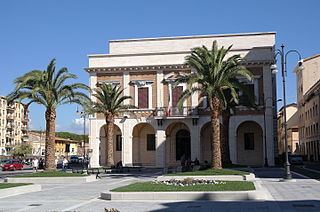
The province of Livorno or, traditionally, province of Leghorn is a province in the Tuscany region of Italy. It includes several islands of the Tuscan Archipelago, including Elba and Capraia. Its capital is the city of Livorno. When formed in 1861, the province included only Livorno and Elba Island. It was extended in 1925 with land from the provinces of Pisa and Genoa. It has an area of 1,211 square kilometres (468 sq mi) and a total population of 343,003 (2012). There are 19 comuni in the province. The coastline of the area is known as "Costa degli Etruschi".
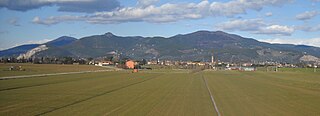
The province of Pisa is a province in the Tuscany region of central Italy. Its capital is the city of Pisa. With an area of 2,448 square kilometres (945 sq mi) and a total population of 421,642, it is the second most populous and fifth largest province of Tuscany. It is subdivided into 37 comuni.

The Tuscan Archipelago is a chain of islands between the Ligurian Sea and Tyrrhenian Sea, west of Tuscany, Italy.

Populonia or Populonia Alta today is a frazione of the comune of Piombino. As of 2009 its population was 17. Populonia is especially noteworthy for its Etruscan remains, including one of the main necropolis in Italy, discovered by Isidoro Falchi.

Montecatini Val di Cecina is a small hilltown and comune in the province of Pisa in Tuscany. Located approximatively 60 kilometres south of Pisa, the medieval town sits on the Poggio la Croce hill overlooking the Cecina Valley and the larger hilltown of Volterra, which lies just 15 km away.

Campiglia Marittima is a comune (municipality) in the Province of Livorno in the Italian region Tuscany, located about 90 kilometres (56 mi) southwest of Florence and about 60 kilometres (37 mi) southeast of Livorno.
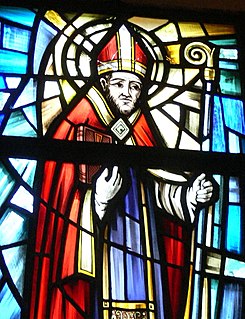
Saint Cerbonius was a bishop of Populonia during the Barbarian invasions. Saint Gregory the Great praises him in Book XI of his Dialogues.

Tuscany is a region in central Italy with an area of about 23,000 square kilometres and a population of about 3.8 million inhabitants. The regional capital is Florence (Firenze).

The Archaeological Museum of Populonia, opened in 2001 in the town of Piombino, Italy, contains artifacts from what was the ancient territory of Populonia during a period ranging from prehistory to late antiquity. The museum contains an active center of experimental archaeology with a focus on the processing of ceramics and stone.

The Archaeological Park of Baratti and Populonia is located in the township of Piombino and covers about 80 hectares between the slopes of the promontory of Piombino and the Gulf of Baratti coast. It is part of The Parks of Val di Cornia and was opened in 1998 for visitors to view some of the archaeological sites and remains found in the new digs archaeological conducted in the area since 1996.
The archaeological area of Poggio del Molino is situated on the northern side of a headland that acts as a watershed between the beach of Rimigliano in the north, and the Gulf of Baratti in the south; to the northern border of the territory administered by the city of Piombino in the Italian Province of Livorno. The structure of Roman age spreads over a high plateau of about 20 m asl which dominates, in the west, the stretch of a sea between San Vincenzo and Elba and to the east, the metalliferous hills and plains of the Campiglia lagoon. The top of the hill is occupied by the beautiful Villa del Barone, built in 1923 by Baron Luigi De Stefano and Assunta Vanni Desideri, the daughter of Eugenio. From a paper of the 16th century, the "Bandita di Porto Baratti", and some archival documents we know that the Poggio owes its name to the mill which was a part of Torre Nuova, the building of coastal defense and a lookout built in the early sixteenth century by Cosimo I de' Medici, on the slopes of the promontory.
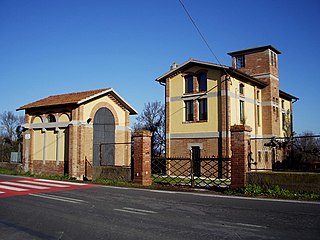
Puntone di Scarlino is a village in Tuscany, central Italy, administratively a frazione of the comune of Scarlino, province of Grosseto. At the time of the 2001 census its population amounted to 345.
Giardino is a rural area in Tuscany, central Italy, administratively a frazione of the comune of Capalbio, province of Grosseto. At the time of the 2001 census its population amounted to 15.

Venturina Terme is a frazione of the comune of Campiglia Marittima . Formerly known as Venturina, it was renamed as Venturina Terme since 1 January 2014 for the importance of its thermal activities.

Populonia Stazione is a village in Tuscany, central Italy, administratively a frazione of the comune of Piombino, province of Livorno. At the time of the 2011 census its population was 234.
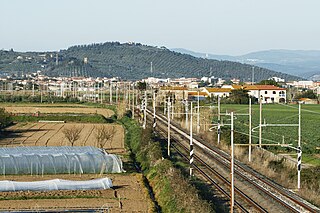
The Campiglia Marittima-Piombino railway line, also known as the Cornia Valley Railway is an Italian railway line that connects the junction at Campiglia Marittima with the port town of Piombino.




















